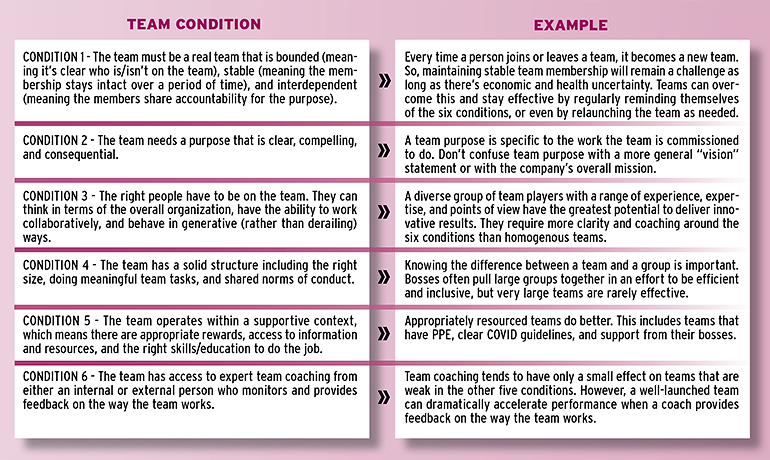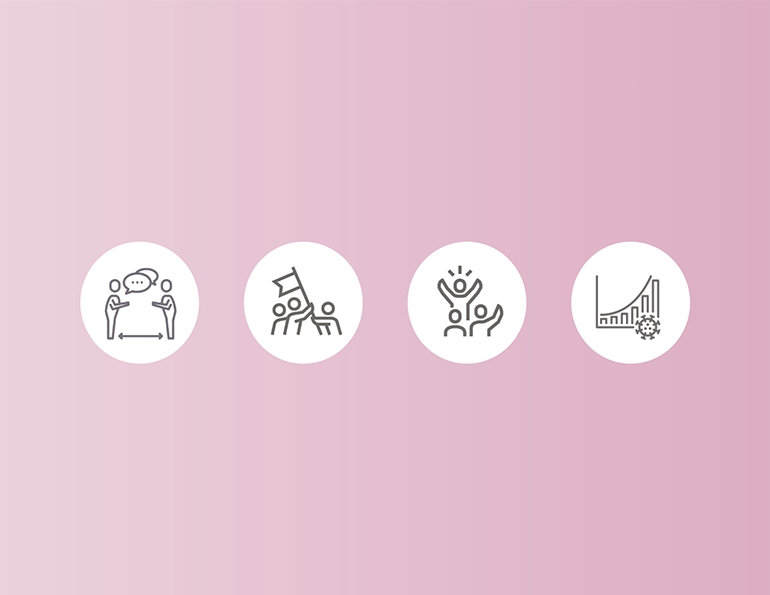As the fog lifts and the skies brighten, leaders will naturally turn their attention from the processes and procedures necessary to run the business to the people who must now make it all happen. Furloughed, laid-off, and COVID-recovering employees are out there waiting. They have missed work, but have they missed working?
Something’s Missing at Work
The definition of normal has been shattered. As we try to put it back together, we realize a few pieces are missing. There’s a persistent worry about the fragility of the human species. Our risk mitigation approaches—and customers’ perceptions of our approaches—are now connected to keeping humanity alive. The world will no longer be about “complying with regulations,” but rather will steer toward a shared responsibility for the well-being and safety of others.
Employees are not the same today as when they left. In fact, no one’s the same. Many had 2020 mapped out and were rather optimistic. However, when it all came screeching to a halt, fear and stress kicked in. Loss of income or job was made worse because there was no end in sight.
Prospective employees, too, have endured an extended period of chronic stress. This has very real physical impacts on people: it leads to increased cortisol levels, accelerated cellular death, decreased brain function in the prefrontal cortex (where memory resides), lower immune system responsiveness, and more.
Guests—who also experienced chronic stress—now have different expectations of every single living, working, or playing space they occupy. While they certainly miss playing outside, their outdoor experience expectations now include their need to feel safe and cared for by those who work at the outdoor businesses they visit. They will be looking through a refocused lens to see that the employees understand and take seriously the health needs of guests.
What Hasn’t Changed?
But there’s one important thing that hasn’t changed: Employees need clarity and a connection to purpose. And while the pandemic has given us chaos and uncertainty, businesses are purpose-built to provide employees with clarity, and business leaders are positioned to deliver it. Doing so is not just good business—it’s a generous, empathetic act of leadership that reduces chronic stress and its impacts.
Research shows that being on a high-performing team—where you experience a state of “flow”—actually counteracts the effects of chronic stress. A high-performing team is one that: a) produces work that meets or exceeds the needs of the team’s “client” (or whomever the team is working for); b) becomes increasingly capable over time; and c) creates individual growth and development for each member as a result of being on the team.
Post-Covid Interactions
As people return to the workplace, they are expecting a new normal. Even though they may not be sure what to expect, they probably aren’t expecting things to be exactly the same. That’s both good and bad.
It’s good because leaders now have a “clean slate” opportunity to reset group and organizational norms. However, it’s also challenging, because employees will be sensitive to anything that feels threatening, unsafe, or risky.
Empathy will be critical in the months ahead to ensure workplaces are safe for people to express their worries without reprisal. Leaders will be encountering people who have truly suffered. In fact, they should assume prospective employees, returning furloughed or laid-off workers, and others have been personally touched by COVID-19.
One leader in the aerial adventure park industry who recently had a COVID-19 scare wondered if aerial adventure parks are truly ready to engage with employees and guests who’ve had (or may have) COVID. That sentiment applies universally.
The person, who will remain anonymous, said: “We need to be able to set our businesses up to toggle between COVID threat levels and our responses to those as it becomes required. We need to continue developing a work culture of respect, compassion, and risk management, and continue to educate our staff and our clients. We need to collaborate more with competitors in our industry as well as align and get involved in making our community groups safer and more respectful of each other.
“We have all experienced a form of trauma during this pandemic, and now we have to focus on our personal healing and do our best to contribute to the healing of our communities and the aerial adventure industry.”
Pitfalls to Avoid
As leaders think about how to interact with their employees, there are a number of common behaviors to avoid. The following behaviors erode trust, create doubt in the minds of others, demonstrate a lack of empathy, and make your organization more likely to have higher voluntary turnover.
1. Don’t make it all about the leader. When employees finally come back, they will not want to hear how hard it was for their leader to work with a skeleton crew to keep things going while they were “getting paid to do nothing.” That’s not only tone-deaf, it assumes that employees would rather not work.
2. Don’t avoid talking about the pandemic’s impact on people. Leaders will want to get down to business, and they should. However, leaders can’t stick their heads in the sand and pretend the pandemic didn’t happen. People will want to share their stories and process their experience as a way to confirm the workplace is safe and humane. Set some limits, but don’t avoid it altogether.
3. Don’t make busy work for its own sake. There are a lot of reasons this is a bad idea, but post-pandemic, people will be hyper-focused on how their skills and talent are being used in the organization. They may be more apt to speculate about being fired. Giving them meaningless busy work will only fuel those thoughts.
4. Don’t underestimate employees’ range of skills. By now, every leader (hopefully) has seen people step up to go above and beyond in helping the business. There are thousands of “Apollo 13” stories out there where people with very limited resources made incredible things happen. Leaders who see beyond a person’s job role and provide opportunities to leverage a range of skills will likely have thriving, adaptive teams prepared for ongoing uncertainty.
5. Don’t forget, abandon, or fail to articulate the vision. Leaders who focus too closely on the day-to-day tasks can end up extending the feeling of stress and frustration by making the mistake of micro managing. Successful leaders specify the ends and leave the means up to their teams.
Spend time restating your vision, and let teams self-organize and self-govern to ensure the company heads in that direction.
Structures to Help Work Work Better
In addition to exhibiting the self-discipline to avoid these five pitfalls, leaders will also need to ensure teams are set up for success when they return. Employees will need and want clarity and structure in order to feel fully engaged in their work. How can you do that quickly?
There are six structural elements research has shown increase the chances that teams will be successful. In fact, these six conditions, in the chart below, predict up to 80 percent of a team’s performance effectiveness.
As you plan to reopen, you will find and hire outstanding individuals, but that doesn’t guarantee team success and business results. Getting the six conditions established in all your teams is a valuable investment to ensure focused team performance, especially during our ongoing period of volatility, uncertainty, complexity, and ambiguity.







